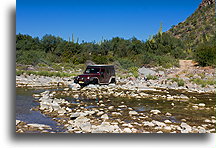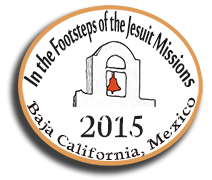I told you so
November 19



Mulege was the next stop on our expedition In the Footsteps of the Jesuit Missions. The riverside Misión Santa Rosalia de Mulege was founded in 1705 in a place known to the Indians as Mulege or great sandbar of the white mouth. Indigenous Cochimi people supported Jesuits in their efforts to erect a church and establish a Catholic mission in this desert oasis. Exactly like all the other newly established mission settlements in the region, within just a decade of the arrival of the missionaries, the local population has dramatically decreased.. In 1768, the Spanish king expelled the Jesuits from New Spain; they were not able to finish the construction of the stone church, which had begun only two years earlier. The Franciscans continued the work, followed by the Dominicans. When the work were completed, the new building soon emptied, as the local population died out completely.



This was the forth Jesuit mission, which we visited. It was easy to realize that, unfortunately, all of them shared the exact same tragic ending. The Spanish missions of Baja California ceased to function and the missionaries abandoned them in a little more than 100 years after the arrival. The reason was always the same. Decimated by epidemics and unknown diseases brought by the Europeans, the local Indian population died out completely, leaving Spaniards without the workforce required to implement and support their projects.
After all, we liked the Spanish colonial architecture. In all the places we have visited so far, we could always find something interesting. Each church was different and each location was exceptional. On that day, we wanted to visit another small mission. San Jose de Comondú was located somewhere in the Sierra de la Giganta, in a place not so far from Mulege. Mexican atlas had marked the road in yellow, which was supposed to mean that that the road was in a decent condition. Of course, not a paved road, but still an easy drive, I presumed.



A few miles after leaving the Rt. 1, we came across a local man driving a pickup truck. To make sure that we are going in the right direction, I asked him about the road to Comondú. He scratched his head, saying probably there is no passage. Is he right? Maybe he has never driven in that direction, or possibly he is not from this area I thought to myself. On the map, road was marked clearly and we continued going ahead.


There were no other vehicles on the stony road, which with every mile was becoming narrower and more difficult. Along the way, we had to cross the river twice. Fortunately, it was quite shallow fording. We stopped before the third ford. This time, Eva could not find an exit from the river on the other side. I consulted the GPS map and realized that we were lost for good. This map did not indicate any road in the area we were. We had to turn back. The sun was going down; we did not have much time left.
On the way back, driving across the river again at the ford, we stopped near the ranch. A few dogs appeared all the sudden and so did the rancher. To our surprise, he was the same person we talked several hours earlier. He asked if we succeeded in reaching Comondú. When he realized that we failed, we heard from him I told you so.


After 6 hours spent on rural roads, we decided to go back to the Rt. 1 and go straight to Loreto. While there, we wanted to top up our water tanks. We found a vendor that sells drinking water in the blue 5-gallon containers for a good price of 15 pesos (1 USD). In order for us to fill our onboard tanks from the sidewalk, not from the middle of the street, I parked the car in the opposite direction to the traffic. Balios has water tanks installed on the drivers side. It was a two-way street, so I did not think it could be a problem. Even before I was able to open the first purchased container of water, two local police officers appeared. They demanded payment for the ticket. Our car was parked in the wrong way. Do you want to pay tomorrow? Ill write a ticket. Or maybe you want to pay now and I will not write anything? They requested 200 pesos (14 USD). I tried to negotiate the price, but they were adamant. This time the drinking water was a little more expensive for us.









